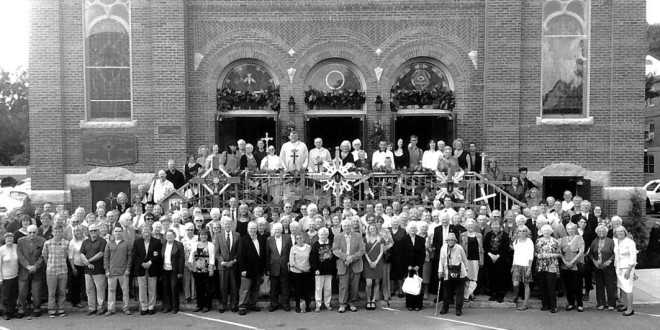By Father Stephen Žukas.
St. Peter Lithuanian Parish in South Boston was established in 1895. Its church was built in 1901. The majority of its Lithuanian parishioners now live outside the neighborhood in surrounding suburbs or even in neighboring states. On September 21st, the parish celebrated its 110 year jubilee. Simona Minns interviews the pastor of St. Peter Parish, Father Stephen Žukas, about his efforts and concerns keeping the Catholic faith alive in the the Lithuanian community in Boston. New challenges have now appeared on the horizon.
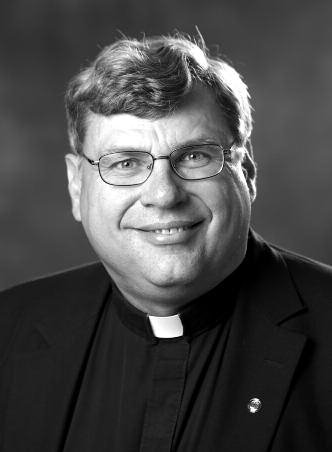
A couple of weeks ago we celebrated the 110th anniversary of St. Peter Church in Boston. The jubilee celebration was attended by many parishioners, family members and Lithuanians from the surrounding communities. Tell us a little about the history of St. Peter parish.
The history of St. Peter can be divided into three periods. The first is the initial wave of Lithuanian immigrants, who formally began worshipping as a community in 1895, six years before St. Peter Lithuanian Church was built. They kept their language, culture, and traditions alive through the practice of their Catholic faith. Each parishioner contributed one week’s pay and many volunteer hours in building the church. The parish was the community’s center for religious and social activities. The second period begins with the arrival of Lithuanian refugees after World War II. The parish welcomed, assisted, and educated the new arrivals. Many individual parishioners sponsored the immigrants. The parish purchased two schools from the City of Boston in order to teach the new parishioners English but also to instruct their children in Lithuanian language and heritage. The parish grew through the practice of the faith and by being an effective networking base which helped families integrate into American life.
The third period started in the late 1960’s when already well-established Lithuanians began to move from the city. Some Lithuanians were forced out of South Boston already in 1938 when the city purchased many of their homes to build a housing project that surrounds the church to this day. But it was the social upheaval and forced busing in the late 1960‘s and early 1970‘s that decimated the South Boston Lithuanian population. Then vandals set fire to one of the parish schools. The other school remained open until 2004 serving the local population. It was at this time that St. Peter became a parish of commuters.
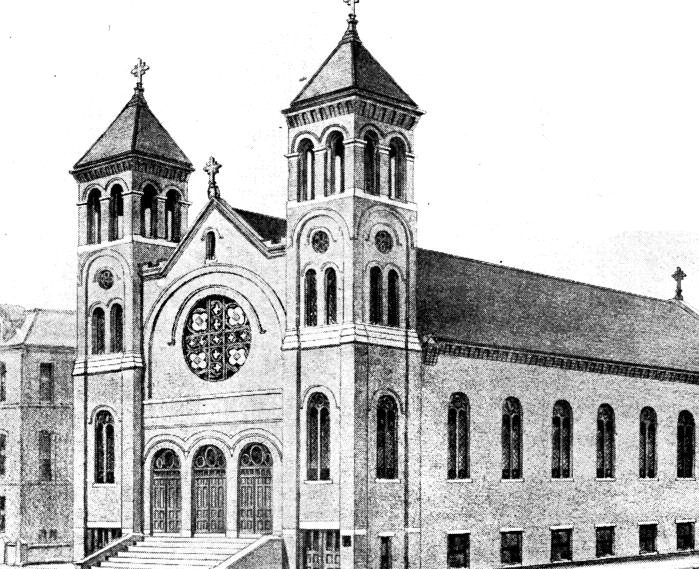 Father Žukas, tell us about yourself. I was raised in Norwood, MA and belonged to St. George Lithuanian Parish, where I was an altar server for nine years. I attended the local public grade school and high school. After graduation, I joined the Navy as a machinist’s mate. After a year and a half of training, part of which was dedicated to nuclear power, I was stationed in San Diego for four years. I participated in 125 Western Pacific Missions visiting places such as Hawaii, the Philippines, Singapore, Australia, Hong Kong, and Thailand. I returned to Boston in 1984 and have not left since. I studied both philosophy and physics at St. John Seminary College and later received a Masters of Divinity from St. John Seminary School of Theology in Boston.
Father Žukas, tell us about yourself. I was raised in Norwood, MA and belonged to St. George Lithuanian Parish, where I was an altar server for nine years. I attended the local public grade school and high school. After graduation, I joined the Navy as a machinist’s mate. After a year and a half of training, part of which was dedicated to nuclear power, I was stationed in San Diego for four years. I participated in 125 Western Pacific Missions visiting places such as Hawaii, the Philippines, Singapore, Australia, Hong Kong, and Thailand. I returned to Boston in 1984 and have not left since. I studied both philosophy and physics at St. John Seminary College and later received a Masters of Divinity from St. John Seminary School of Theology in Boston.
How did you become pastor of St. Peter parish?
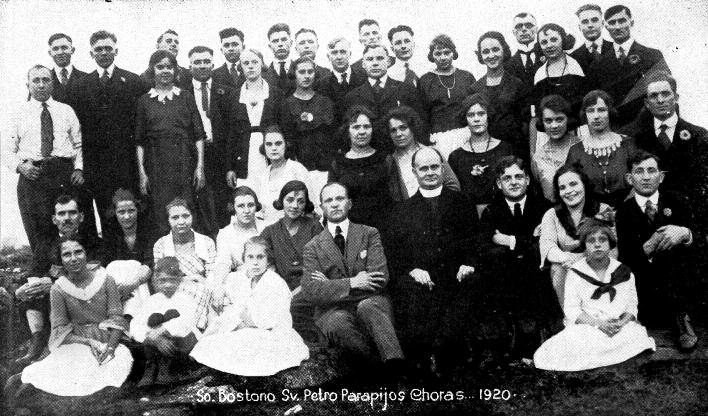
I became pastor of St. Peter Lithuanian Parish on October 5, 1998. I have been here 16 years. After St. George Lithuanian Parish in Norwood closed, former parishioners mentioned me to the then acting pastor of St. Peter, Msgr. Albert Contons I was then serving at St. Margaret Parish in the Dorchester neighborhood of Boston, just two miles from St. Peter. Msgr. Contons spoke about me to Bishop Paulius Baltakis, who then consulted with the Archbishop of Vilnius, Cardinal Audrys Bačkis. Cardinal Bačkis contacted Bishop William Murphy in Boston, requesting that he confer with Cardinal Bernard Francis Law. Cardinal Bačkis‘ requested permission to host me in Vilnius for one year so that I could learn the Lithuanian language and customs, and eventually step in as pastor of St. Peter. Meanwhile, Msgr. Contons treated me to a monthly lunch hoping to interest me in this plan. I accepted Cardinal Law’s offer and spent one year studying in Vilnius. I also spent a month with my newly discovered relatives in the cities of Balbieriškis and Prienai. I was appointed pastor two months after I returned to Boston.
I know that you learned to speak Lithuanian as an adult. What inspired you to learn the language? What was the process like?
I have been interested in my Lithuanian heritage since the 9th grade, when my Earth Science teacher asked the class, “What nationality are you?” I was the only student who did not have more than one nationality. The entire class looked at me and asked, “You’re only one thing?” I knew then that being Lithuanian was special.
My parents came from a generation that encouraged blending into American culture. They wanted to save their children from the difficulties their parents encountered when they came to the United States. Both my parents, however, attended Lithuanian Catholic Schools – my father in Cambridge, MA, and my mother in Worcester. They were taught Lithuanian, but only spoke it only during Christmas time, so that their children would not get wind of their gift giving plans.
The Archdiocese of Boston paid all of my expenses while I studied at Vilnius University’s Foreign Students’ Language Program. I studied with students from 16 different countries. I had two major responsibilities: to study and to serve the community of Discovery of the Holy Cross parish (Lith: Šv. Kryžiaus Atradimo), more commonly known as Calvary parish (Lith: Kalvarijos) in Vilnius.
My parents came to Vilnius to see me “graduate” from the university’s summer program. I will never forget the look on my teachers’ faces when they realized that my parents spoke Lithuanian!
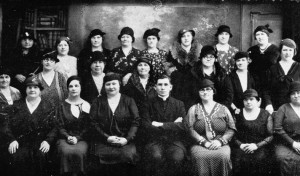
Do you work at any other parishes besides St. Peter?
In the past year I have been asked twice to help at other parishes. During October and November of last year, at the request of the Archdiocese of Boston, I served as an administrator of St. Ann’s Parish in the Dorchester neighborhood. I was concerned about this assignment, but the parishioners turned out to be very understanding. It was difficult for them to be without a permanent pastor, and they realized it must be difficult for me to serve two parishes. The two parishes had very different congregations. But it worked out nicely for the six weeks that I was there.

Based on my positive experience at St. Ann, Fr. Peter Casey, the pastor of St. Agatha Parish, in Milton, MA,, asked me to be Parochial Vicar during his last year at the parish. I have now been serving there for four months. What a different parish! There are two daily Masses and an average of three funerals and two weddings per week. Parishioners are constantly using the parish buildings: there are even meetings in the rectory, since so much goes on at once. Of course, St. Peter cannot function like this since so many parishioners live a distance away from the church. This arrangement of serving two parishes is working so far, but I do find myself tired by the end of the day. Under this arrangement, St. Agatha parish pays St. Peter for half of all my expenses.
How has St. Peter parish changed since you became pastor?
The biggest change has been in Mass attendance and Mass participation. Mass attendance has gone down. This is most noticeable among descendants of the first wave of immigrants, who are either no longer able to come due to physical limitations or whose children do not wish to carry on the tradition of coming to St. Peter. It is also apparent among the new immigrants. When I first came to the parish, it was common to see twenty to thirty new immigrants at Mass. Since Lithuania’s admission into the European Union and its adopting of a more liberal mindset, I am grateful if I see anyone from the latest wave of immigrants.
Although attendance is down, participation is up. Parishioners are showing their dedication to the parish through their greater financial commitment to the weekly offertory. They are more active than before. Take for example the “Young at Heart” Music Ensemble, which continues to grow and develop every year. It is a gift from God to the parish.
What additional activities can parishioners find in St. Peter church?
There are the “Why Catholic?” groups, which combine prayer, reflection, and faith sharing. The groups meet for six 90 minute sessions twice a year. Our parish has participated for five years and presently has six groups, four in Lithuanian and two in English. These groups have become such a part of the parish’s identity that I cannot imagine our parish without it.
We also have a Day of Reflection on a Saturday before Christmas and Easter. These are held in Lithuanian.
Confession is available every Wednesday during Lent and before every Sunday Mass at St. Peter. Preparation for the Sacraments of First Penance and First Communion is held for children grades 1-2 and the Sacrament of Confirmation for grades 8-9.
What changes are coming to St. Peter Parish, and what should the Lithuanian community expect in the near future?
Due to the shortage of priests and financial constraints on many parishes, the Archdiocese of Boston is attempting to make parish operations more efficient, while continuing to spread the Good News of the Catholic faith. The program is called “Disciples in Mission.” St. Peter will be working together with St. Vincent de Paul Parish, which is located one block behind the Lithuanian Club, and St. Monica/St. Augustine Parish, which is one block from Andrew Square.
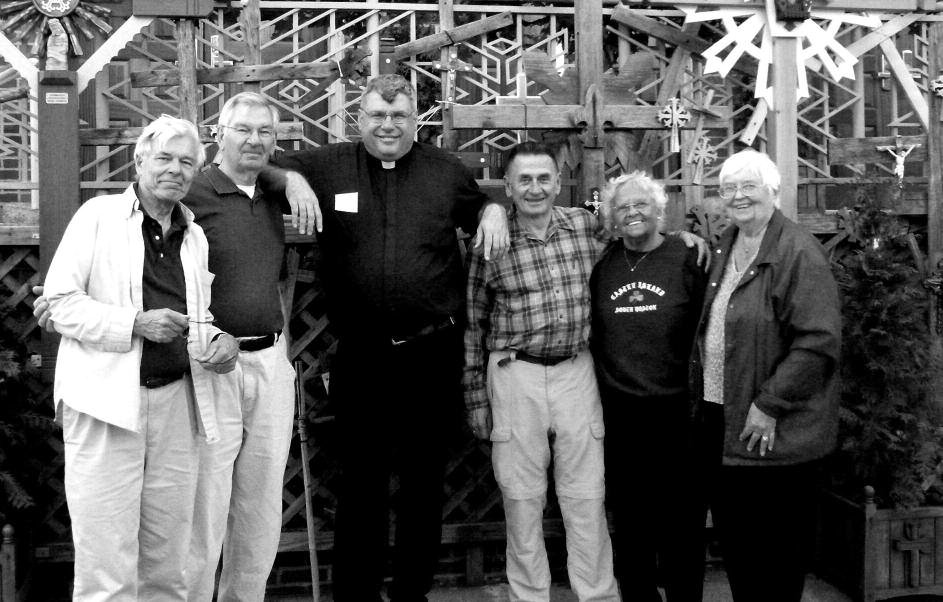
Dilba, Pastor Žukas, Gintaras Čepas, Wanda Griganavičius Kiely, and Dana Dilba.
When this collaborative of parishes is formed on June 2, 2015, I will have to resign as pastor of St. Peter. St. Peter will no longer have its own pastor; he will be shared with the two other parishes. As I understand it, that there will be one, maybe two, priests to help, known as parochial vicars. The new pastor will have to decide how St. Peter will function, especially since most of the Lithuanian parishioners live outside of South Boston. There will be at least one Mass celebrated at St. Peter Church each Sunday morning. The pastor will also decide how the Lithuanian language will fit with the larger demands of the collaborative. It is possible that parts of the Mass which are led by parishioners will be in Lithuanian, even though the priest celebrating Mass only speaks English.
Is St. Peter church open only for Lithuanian community members, or is it open to all nationalities?
Presently people from Cape Verde and the Philippines attend the English language Sunday morning Mass. Parishioners of Lithuanian descent, as well as believers from Vietnam, Haiti, and Central America attend weekday morning Mass. All are welcome. However, if the Sunday Morning Mass schedule is reduced from two Masses to one, then adjustments will have to be made – at least one reading and part of the homily will have to be in English. Will that be enough to make non-Lithuanians to feel welcome? That is up to them.
How do you see our parish in 10 years?
My dream is for the Greater Boston Lithuanian Community to see the value of having a parish as a center for the profession of faith and cultural life. I do not know of any successful Lithuanian community in the United States without a Lithuanian parish. It would be wonderful to see younger immigrants taking the reigns of leadership within the parish. This decision is up to them.
Father Žukas, thank you for sharing your thoughts and concerns! q Simona Minns is a Lithuanian jazz singer, kanklės player, arranger and composer. She is a parishioner of St. Peter parish and is an active member of the Boston Lithua – nian community. Presently Simona is studying Contemporary Writing and Production at the Berklee College of Music in Boston.
 DRAUGAS NEWS Lithuanian World Wide News in English
DRAUGAS NEWS Lithuanian World Wide News in English
